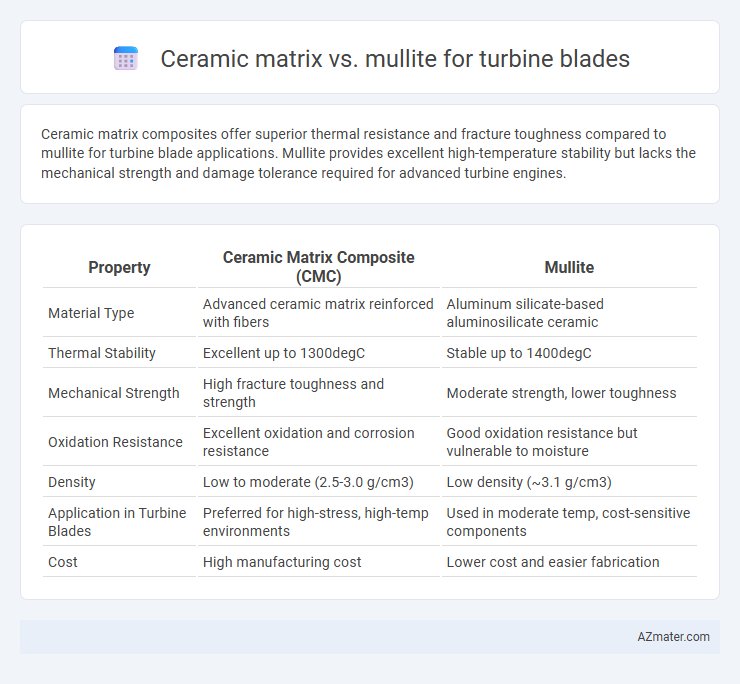Ceramic matrix composites offer superior thermal resistance and fracture toughness compared to mullite for turbine blade applications. Mullite provides excellent high-temperature stability but lacks the mechanical strength and damage tolerance required for advanced turbine engines.
Table of Comparison
| Property | Ceramic Matrix Composite (CMC) | Mullite |
|---|---|---|
| Material Type | Advanced ceramic matrix reinforced with fibers | Aluminum silicate-based aluminosilicate ceramic |
| Thermal Stability | Excellent up to 1300degC | Stable up to 1400degC |
| Mechanical Strength | High fracture toughness and strength | Moderate strength, lower toughness |
| Oxidation Resistance | Excellent oxidation and corrosion resistance | Good oxidation resistance but vulnerable to moisture |
| Density | Low to moderate (2.5-3.0 g/cm3) | Low density (~3.1 g/cm3) |
| Application in Turbine Blades | Preferred for high-stress, high-temp environments | Used in moderate temp, cost-sensitive components |
| Cost | High manufacturing cost | Lower cost and easier fabrication |
Introduction to Turbine Blade Materials
Ceramic matrix composites (CMCs) and mullite are critical materials in turbine blade applications due to their high-temperature resistance and mechanical strength. CMCs offer superior fracture toughness and thermal shock resistance compared to mullite, which is a ceramic oxide known for its excellent thermal stability and low thermal expansion. The choice between ceramic matrix and mullite depends on specific turbine operating conditions, such as temperature, oxidation environment, and mechanical load requirements.
Overview of Ceramic Matrix Composites
Ceramic matrix composites (CMCs) offer superior thermal stability and resistance to oxidation compared to traditional mullite ceramics, making them ideal for turbine blade applications exposed to extreme temperatures. Unlike mullite, which is a single-phase aluminosilicate ceramic known for its low thermal expansion and moderate strength, CMCs are engineered by embedding ceramic fibers into a ceramic matrix, enhancing toughness and damage tolerance. This fiber reinforcement enables CMCs to withstand higher mechanical stresses and thermal cycling, extending turbine blade lifespan and improving engine performance.
Mullite: Properties and Composition
Mullite, composed primarily of 3Al2O3*2SiO2, exhibits exceptional thermal stability, low thermal expansion, and high creep resistance, making it ideal for turbine blade applications. Its composition provides excellent resistance to oxidation and corrosion at temperatures exceeding 1400degC, outperforming many ceramic matrices in harsh environments. This combination of properties enhances turbine blade longevity and efficiency by maintaining structural integrity under extreme mechanical and thermal stresses.
Thermal Stability: Ceramic Matrix vs. Mullite
Ceramic matrix composites (CMCs) exhibit superior thermal stability compared to mullite, maintaining mechanical integrity at temperatures exceeding 1,200degC, making them ideal for turbine blades operating in extreme conditions. Mullite, with a melting point around 1,850degC, offers good thermal shock resistance but suffers from lower fracture toughness and reduced stability under cyclic thermal loads typical in turbine environments. The advanced microstructure of CMCs enhances oxidation resistance and prolongs service life, outperforming mullite in high-temperature turbine blade applications.
Mechanical Strength Comparison
Ceramic matrix composites (CMCs) typically exhibit superior mechanical strength and fracture toughness compared to mullite when used in turbine blades, enabling better resistance to high thermal stresses and mechanical loads. Mullite, while offering excellent thermal stability and oxidation resistance, has lower tensile strength and fracture toughness, which limits its performance under extreme mechanical stress. Advances in ceramic matrix composites enhance blade durability through improved crack propagation resistance and higher flexural strength, making them more suitable for high-performance turbine applications.
Oxidation and Corrosion Resistance
Ceramic matrix composites (CMCs) exhibit superior oxidation resistance due to their dense microstructure and stable ceramic phases that form protective oxide layers at high temperatures, outperforming mullite in turbine blade applications. Mullite, while resistant to thermal shock and possessing moderate corrosion resistance, tends to form porous oxide scales that compromise long-term durability in aggressive oxidative environments. The enhanced corrosion resistance of ceramic matrix materials results from their ability to maintain structural integrity and chemical stability under extreme turbine operating conditions, reducing material degradation and extending blade lifespan.
Fabrication and Processing Methods
Ceramic matrix composites (CMCs) for turbine blades are typically fabricated using methods such as chemical vapor infiltration (CVI) and polymer impregnation and pyrolysis (PIP), enabling a tailored microstructure with enhanced toughness and thermal resistance. Mullite ceramics, favored for their excellent thermal stability and low thermal expansion, are commonly processed through sintering techniques including pressureless sintering and hot pressing, ensuring high density and mechanical strength. The choice between CMCs and mullite directly impacts turbine blade performance, as CMCs offer superior damage tolerance while mullite provides cost-effective fabrication with reliable thermal shock resistance.
Cost and Availability in Industry
Ceramic matrix composites (CMCs) generally incur higher production costs due to complex manufacturing processes and raw material expenses, limiting widespread industrial availability for turbine blades compared to mullite-based materials. Mullite offers a more cost-effective alternative with abundant raw material sources, enhancing its accessibility and scalability in manufacturing turbine components. Despite lower cost, mullite's mechanical and thermal properties may not match the performance capabilities of advanced ceramic matrix composites in high-temperature turbine applications.
Performance in High-Temperature Environments
Ceramic matrix composites (CMCs) exhibit superior thermal stability and oxidation resistance compared to mullite, enabling turbine blades to operate efficiently at temperatures exceeding 1200degC. Mullite, while offering good thermal shock resistance and lower density, generally underperforms against CMCs in mechanical strength and creep resistance under prolonged high-temperature conditions. The enhanced fracture toughness and thermal conductivity of ceramic matrix materials make them preferable for maintaining structural integrity and performance in extreme turbine environments.
Future Trends and Material Innovations
Ceramic matrix composites (CMCs) continue to advance with the integration of silicon carbide fibers and nano-engineered interfaces, enhancing thermal stability and fracture toughness for turbine blade applications. Mullite-based ceramics demonstrate promising developments in doping strategies and additive manufacturing, offering superior thermal shock resistance and creep performance under extreme gas turbine environments. Future trends emphasize hybrid CMC structures combining mullite phases and advanced coatings to achieve weight reduction, enhanced oxidation resistance, and prolonged service life in high-temperature aerospace components.

Infographic: Ceramic matrix vs Mullite for Turbine blade
 azmater.com
azmater.com